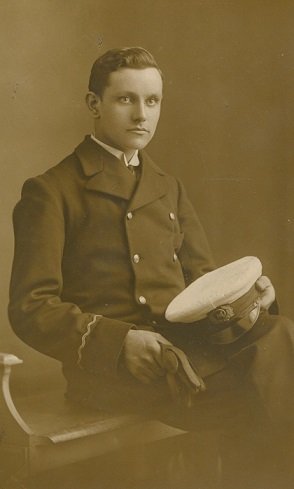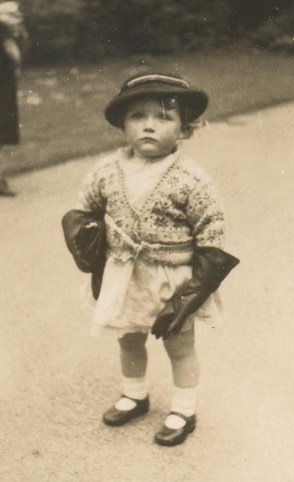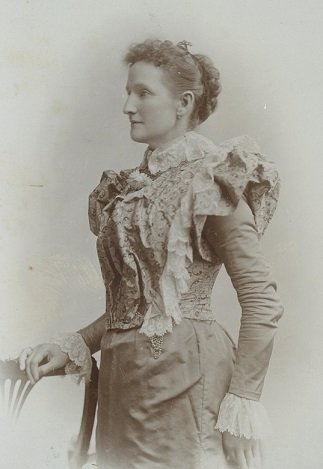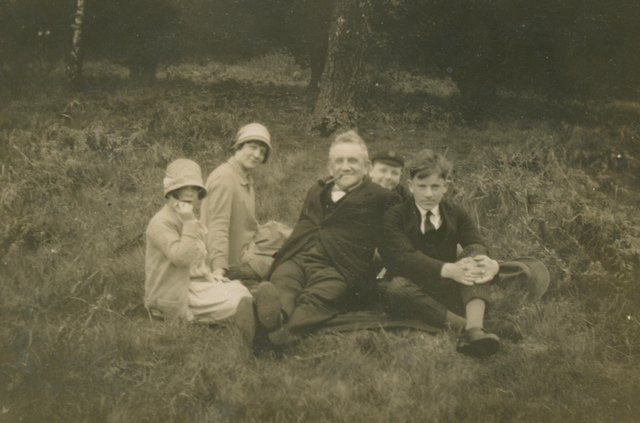The Ancestor Chest
My mother once told me that you’re not a proper adult until both your parents are dead.
Thanks, Mum. Could have done without that particular life opinion. Some years later, on Radio 4, someone wise stated that – definitionally – you’re an adult when you stop obsessing about your own life and look-up to the ones around you.
Still working on that.
I learned from experience that parental deaths produce much administration. Following the emotional and relationship watershed, the months following our mother’s and, six and a half years later, father’s, death were busy periods – occupied by death certificates, wills, probate, paying off utilities, the closure of bank accounts, redirecting mail, liaison with government agencies, the disposal of hazardous waste (when a 1970s ironing board turned out to be covered in asbestos), the singing of traditional songs, and many trips to the charity shop.
Personally, I found that process of loose-end-tying cathartic; a vehicle for setting in order my feelings about the past. The final, and most absorbing, phase of estate-closure was dealing with the three-foot-long, hardwood, iron-bound chest, which formerly lived in the corner of my beloved father’s bedroom, in the bungalow in the Stour Valley where he lived out his dotage.
The Chest and its Treasure
The chest was the place into which someone, at some time, had decided to keep the most enlightening artefacts left by our ancestors – photographs, papers and keepsakes from our parents lives, their parents lives, and their predecessors further back.
It had always been there, upstairs in Mum and Dad’s room. I’d long known what was in the chest. Every now and again it produced a talking point. Someone would rummage around and dig out a photo or communique of note, such as an amusing school report of a now-aged relative, or a once-secret letter, alluding to scandalous carnal encounters between lovers during a more conservative era.
The only time I’d had a serious look at the chest’s innards was when we’d moved out of the family home, in 2010. On that occasion I’d taken out the contents and spread them over the surface of Dad’s double bed, picked out a letter at random and read the first page.
The letter was written by my maternal grandfather, Peter Marsh (1898 to 1956), after whom I’m named, and who died, tragically and before his time, 18 years before I was born. The letter was written from a peace conference, in Warsaw, in the 1950s, to his wife, my grandmother, Bess. The letter spoke movingly of the international meeting, held in the shadow of World War II, where he wrote that they discussed “peace, just peace”. It was clear that the chest’s contents could be an illuminating corpus for the current generation and those after. But there was so much material, and so varied.
I re-packed the contents onto wide corrugated box-trays to create some order out of the jumble. Then the chest went with my father to East Bergholt, and remained there with him until he died.

If Not Now, When?
When we cleared out Dad’s bungalow, in February 2016, the chest went into storage with other family flotsam and furniture. One such possession was a large, framed Edwardian-era picture of two daintily clad young ladies and a cherubic lad. It had been hanging about in family storage spaces for half a century. We’d forgotten who it depicted.
The picture caused me to reflect that, if the chest’s contents wasn’t tackled, the next person to face the decision on its disposal might be 50 years away – at which point its context would be ever more distant, and its significance less-knowable. It boiled down to this: I could either have a go at capturing and setting in order the material in the chest, or I could leave it for some future generation. And if not me, who? And if not now, when?
If I set sufficient store in my family’s twentieth-century journey for it to be preserved by more than a few fast-to-fade oral traditions – to be mentioned in passing during occasional get-togethers between aging cousins – that higgledy-piggledy jumble must be turned into an orderly record of the past. The place to start was the photographs.
That winter, before the chest went to storage, I took out several large handfuls of photos and packed them into a small cardboard box, which I brought back to London. The box spent six months in a corner while I helped organise the urgent aspects of Dad’s estate, got married and went on honeymoon. Then, one Sunday at the end of 2016, I went in.
The Production Line, Part 1
This is what I did:
First, I took all the photos out of the box I’d brought back and spread them across the kitchen table. I contemplated the morass a while, then began piling them into high-level subsets: Photos from the Marsh family in black & white; Marsh photos in colour, Black and white photos from the Baker family, Donnelly photos, Unknown photos etc ... To start with, Unknown was the biggest pile.
Once they were in piles, I began scanning. I’d commandeered an old flatbed scanner from my friend Tony, and began imaging as many pictures as would fit onto an A4 plate at a time. New piles emerged labelled scanned. This stage stretched to weeks, during which I’d grab the odd hour to whip through scans. Next, I began opening, rotating and cropping the scans on Microsoft Paint, leading to hundreds of individual electronic images. These I uploaded to the cloud.
Some of the early-twentieth-century photos were barely an inch square. As I got into the routine of blowing them up on screen, all sorts of things jumped out, and I began to get a granular sense of the material I was sorting through. From that point, I could make judgement calls as to how to clump photos in the online display albums I was working towards.
This meant drawing red lines, and took quite a bit of thinking. The collection would ultimately turn out to be 2,000 images, taken across 130 years, by tens of photographers, of subjects from three families. It was a continuum. Where to draw dividing lines? In the end, I split-up the bulk of that bubbling record into decade-long, or multi-decade-long, clumps, with a few separate thematic clumps where such themes presented themselves. Dating the photos started as educated guessing. With 85 years between the divider and the oldest dividing line, I probably called quite a few of them wrong.
By November 2016, I’d scanned and filed that first box. It came to 698 photos.

Light Reflections
• After half a century, the workaday is enthralling. Pictures of people one knew, decades before one knew them: cousins I knew in gruff middle age, as funky young dudes; great uncles I remember as shrunken old men, as lean handsome adventures; Aunty Paddy (1891 to 1985) – who I crossed paths with when she was 90 and I was 7 – as a marriageable 20-something. Dad as a hard-looking young man, not an ounce of fat on him. Mesmerising pictures of Mum as a toddler.
• There are eyebrow-raising moments. The British soldier in Palestine grinning while holding a severed pig’s head was presumably an associate of my father. The multiple photos of a toga party turning into a sex orgy was a different flavour of shock. I was thankful not to recognise any of the participants.
• Identifying dead ancestors is a quickly improvable skill. Before starting this, I didn’t know what my Great Aunt Clarissa (1886 to 1972) looked like. Towards the end, I became so well-versed with how her features changed through her life, I could date newly uncovered photos by how old she looked.
• Multiple minor mysteries are thrown up. When and where was that street party? Who’s that smiling couple? That handsome lady? What’s the significance of that ship? And there are lots of ships, given that’s how overseas travel was conducted during the decades in which many of the older, and most interesting, images are from – and that I come from a family of travellers.
• Labelled photos are like gold dust. One labelled shot from 100 years ago slots 10 bit of information into place. All you need is a date and a name. Very few are so labelled. It probably didn’t occur to people. What was obvious 100 years ago is unfathomable a century later – like that scene in The Lord of the Rings when they’re trying to deduce the phrase to enter the Mines of Moria. Everyone knew the password, so no one wrote it down.
• Old photos have a singular power to tug heart strings. An intense flow of minor revelations run through one’s head while looking at this stuff, generating a rich emotional journey. Dimly-remembered scenes brought to life. Others, half-known from hearsay, wrought real in photographic form. A boating trip I dated to 1937 – all the gang was there – now known only via its photos, and only to me. What my Great Grandmother’s handwriting looked like. A sense of how she recorded her thoughts. A century of living, gathered-up in a net.

Knitting Together
Clues, deduction and simple face-matching soon reduced the Unknown pile. An early Rosetta Stone was an 1880s family photo of a couple, three elder boys and two younger girls. That specific family unit shape matched only one branching of the rough family tree provided by my Uncle Pip. By identifying those seven individuals, I placed a score of additional pictures.
The next lightbulb moment was that a series of nineteenth-century pictures of different women at different ages were, in fact, the same woman at different ages: Great Grandmother Elizabeth Marsh (1857 to 1938), who had a penchant for having her photo taken. She’s the earliest ancestor for whom there was a full 20s-to-70s photographic life arc.
The final meta-clue was gaining access to the comprehensive family trees built by my cousin Thia on Ancestry.com. At once, I had a database of my mother’s family back to the early-nineteenth century, with mini biographies, and the dates of births, marriages and deaths. From then on, my dating became more granular, and I started to perceive details such as, for example, the changing physical condition of Grandfather Peter Marsh between his early- and mid-50s. He put on a lot of weight in the years leading up to his heart attack.
Many photos went from anonymous to enthralling once on the computer. What’s unidentifiable on an inch-square photo is clear down to the facial expressions when blown-up on a 27-inch screen. The most magnificent example was the picnic photo of Great Grandfather Jon the Don and his offspring, originally in the Unknown pile, but elevated to one of the most interesting shots in the archive once I realised what it was.
Snap. 1926. There they are. Grandmother Bess, lovely at 21. Great Uncle John, dashing at 15. Great Aunt Cynthia – a grey-haired matriarch of my first 34 years on Earth – as a bonnet-clad six-year-old. All in their flowering years. Rich lives before them. That one bright, forgotten moment, now passed beyond the horizon of living memory, caught in crisp photographic clarity.

More from me:
My book (UK)
My book (US)
My website
I love the fashion from the 1880's and I scan photos for my family history as well and it is very good to do so. Thanks for sharing.
Welcome on board :) Now that's a treasure chest :O sounds like a pretty intense but immensely rewarding job sorting through all that history!
Great article! I look forward to your future posts!
That's awesome, thanks for sharing :) I have an idea for you since you have those pictures in a digital format. Try uploading all the collection to Google Photos. It will automatically recognize objects and faces. Then you can search the photo collection as you would do in google search. For example, you can search "food" then all the pictures with food in them will be sorted. Or you can search for "nature" and all pictures taken in nature will show and so on. Then if you have the dates, you can sort them by date and see some interesting patterns maybe. Google can also sort them according to faces with a bit of help from you since it has a hard time recognizing faces of people as they grow up.
Welcome thejollypilgrim!
eSteem is the application that improves your experience on Steem. You have full control over your data and content, unlike some apps we don't use our users to promote our application or services.
We have Mobile application for Android and iOS users. We also have developed Surfer Desktop application that helps you to gain new followers and stay connected with your friends, unique features - notifications, bookmarks, favorites, drafts, and more.
We reward our users with encouragement upvotes as well as monthly giveaways rewarding Spotlight top users and active Discord users.
Learn more: https://esteem.app
Join our discord: https://discord.gg/8eHupPq
Hello @thejollypilgrim. Welcome and congratulations on joining this amazing platform. You have made the right choice. I am a partiko partner, to make it easier for you to do activities in the server I suggest you join @partiko. Let's Joint:
Partiko website: https://partiko.app/
Blog: https://steemit.com/@partiko
Discord: https://discord.gg/DTYKPX
Twitter: https://twitter.com/PartikoTeam
Posted using Partiko Android
Welcome to Steem thejollypilgrim! Partiko is officially the fastest and most popular mobile app for Steem. Unlike other Steem apps, we take 0% cut of your earnings! You can also be rewarded with Partiko Points while using Partiko and exchange Partiko Points for upvotes!
Partiko for Android can be downloaded here on Google Play and the iOS version is available here on the App Store.
If you have more questions, feel free to join our Discord channel and ask @crypto.talk, we're always here to help!
Thank you so much for your interest!
Congratulations @thejollypilgrim! You have completed the following achievement on the Steem blockchain and have been rewarded with new badge(s) :
Click here to view your Board
If you no longer want to receive notifications, reply to this comment with the word
STOPWelcome to steemit @thejollypilgrim.
Welcome the new steemians. Have a great day!